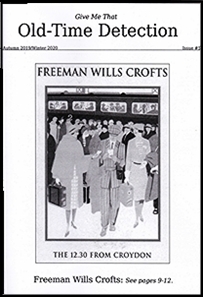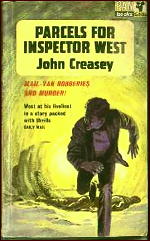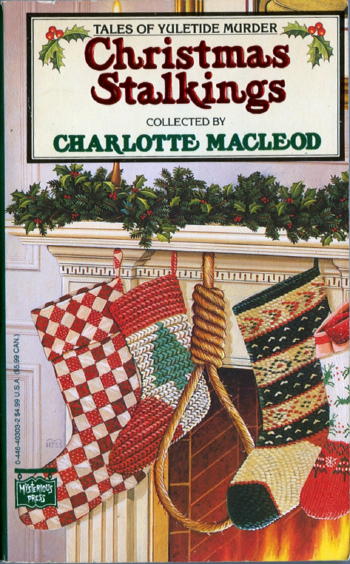Search Results for 'Patricia Moyes'
Did you find what you wanted ?
Tue 9 Feb 2021
Posted by Steve under
Reviews[7] Comments
REVIEWED BY MARYELL CLEARY:
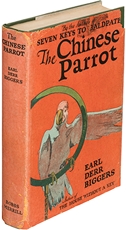
EARL DERR BIGGERS – The Chinese Parrot. Charlie Chan #2. Bobbs Merrill, hardcover, 1926. Pocket #168, paperback; 1st printing, July 1942. Reprinted many times since, in both hardcover and paperback.
The Charlie Chan stories are classics of detective fiction. However, classics of the past are not always to be read with enjoyment in the present. I reread The Chinese Parrot to see how well it holds its own with modern mysteries. My verdict is that it does so very well. The many details which are of its own time add to the interest rather than detracting from it: the use of the telegraph, the “flivvers,” the ubiquitous Chinese “boys” as servants.
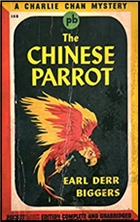
The story is one of murder surmised rather than known, an atmosphere of something wrong rather than a crime to be unraveled. It progresses as theory after theory put forth by young Bob Eden is proven wrong by Charlie Chan’s detective work.
It is most unbelievable when Bob continues to bend to Charlie’s plea not to hand over the pearl necklace which he is supposed to deliver. Evidence of anything wrong at the Madden ranch is slim indeed; I have trouble believing that any impatient young man would procrastinate so on only the word of a Hawaiian detective he has never known before. However, it is necessary to the story that he delay, so delay he does.
And delay at last brings the story to a smashing conclusion. Dated? Yes, of course, Outdated? Never.
– Reprinted from The Poison Pen, Volume 4, Number 5/6 (December, 1981). Permission granted by publisher/editor Jeff Meyerson.
NOTE FROM THE EDITOR: It has been a while since one of Maryell’s reviews has appeared on this blog. Since that is so, let me reprint the following, which I wrote as a followup note to the first of her reviews here. This is from November 19, 2009:
Maryell Cleary, who died in 2003, was an ordained minister of the Unitarian Universalist Church as well a voluminous reader and collector of detective fiction. I met her once while she was taking a trip by car through New England. She stopped here to look at my collection and to go through my duplicates, and of course we spent a long, wonderful afternoon talking about each of our favorite characters and authors.
Maryell was especially fond of mysteries in the Golden Age tradition. In fact, she had a letter in the same issue of The Poisoned Pen as the one above in which she protested mildly that fans of private eye novels had taken over the pages of recent issues! More coverage, she requested, of authors like Martha Grimes, Ruth Rendell, Patricia Moyes, Charlotte MacLeod, Robert Barnard, Marian Babson, Dorothy Simpson and P. D. James.
To that end she also wrote many reviews and articles herself for the mystery fanzines of 20 and 30 years ago, including the still late lamented Poisoned Pen, published for many years by Jeff Meyerson. I’ve conferred with Jeff, and we both agree that she would have liked her reviews to go on after her. They will appear here on a regular basis for some time to come — she wrote a lot of them!
Sun 2 Feb 2020
REVIEWED BY MIKE TOONEY:
(Give Me That) OLD-TIME DETECTION. Autumn 2019/Winter 2020. Issue #52. Editor: Arthur Vidro. Old-Time Detection Special Interest Group of American Mensa, Ltd. 36 pages (including covers). Cover image: The 12.30 from Croydon.
With many Golden Age (GAD) writers nowadays seeing reprints for the first time after years of neglect, Arthur Vidro’s Old-Time Detection (OTD) is more timely than ever, an invaluable resource for neophyte and experienced readers alike. The insights and information contained in any given issue of OTD make it a worthwhile reservoir from which Golden Age enthusiasts may drink with pleasure.
~ “From the Editor” by Arthur Vidro:
Vidro echoes the sentiments of many devotees of classic detective fiction: “. . . every time a publisher [such as Penzler Publishers] reprints a novel of an old-time author, or (as Crippen & Landru does) collects into a book for the first time the short stories of an old-time author, it is cause to rejoice.”
~ “Looking Backward” by Charles Shibuk and “A Sidebar by Arthur Vidro” (2 pages):
Shibuk discusses the comments supplied by Jacques Barzun and Wendell Hertig Taylor for A Book of Prefaces to Fifty Classics of Crime Fiction, 1900-1950: “The collaborators have endowed these highly literate prefaces with all the wisdom of their many years of reading experience. Their pithy remarks are always interesting, enlightening, and a good example of their critical expertise and mandarin tastes.” Arthur Vidro helpfully appends a complete list of those “Fifty Classics.”
~ “Christie Corner” by Dr. John Curran (2 pages):
The world’s foremost expert on Dame Agatha summarizes recent developments in Old Blighty, with comments of the newest collection of Christie stories, The Last Séance: Tales of the Supernatural, many of them coming from The Hound of Death (1933); TV adaptations of Christie’s works, some more successful (i.e., being true to the originals) than others; and two festivals honoring She Who Had a Talent to Deceive.
~ “Give Me That Old-Time Detection Film Music” by Marvin Lachman (3 pages):
Lachman highlights the musical scores of classic detective/mystery/crime movies from the 1930s, ’40s, ’50s, and a little beyond, many of which are very memorable, even haunting, such as the ones in The Letter and Double Indemnity (both by Max Steiner); Laura (David Raksin); The Big Sleep (Steiner again); Spellbound, The Naked City, and The Private Life of Sherlock Holmes (Miklos Rozsa in all three cases); Sunset Boulevard (Franz Waxman); and Murder on the Orient Express from 1974 (Richard Rodney Bennett).
~ Mega-Review: Mycroft and Sherlock (2018) by Kareem Abdul-Jabbar & Anna Waterhouse; reviewed by Michael Dirda (2 pages):
A former basketball superstar (with an acknowledged writing partner) has another go at modifying the Sherlockian mythos in this sequel to Mycroft Holmes (2015). The story introduces a character many readers may have heard of, an “intense young man” who is “arrogant, stubborn, argumentative, and almost bloodthirsty in his taste for newspaper accounts of the latest crimes and atrocities.” Dirda concedes that “it moves along briskly, and the reader’s interest never flags,” but it does have its flaws.
~ “Spotlight on Freeman Wills Crofts” by Charles Shibuk (4 pages):
For mystery fans Crofts needs no introduction, being a pioneer of the police procedural subgenre starting with The Cask (1920, published the same year as Agatha Christie’s first book), a novel which received high praise from Anthony Boucher: “Possibly the most completely competent first novel in the history of crime, it is the definitive novel of alibis, timetables — and all the absorbing hairsplitting of detection . . .” With some exceptions, Crofts’s later works adhered pretty much to the same pattern, especially after he introduced his most famous detective, Inspector French.
~ “35 Years Ago: Mystery Reviews” by Jon L. Breen (3 pages):
Deadly Reunion (1975; 1982 in the U.S.) by Jan Ekström:
Unlike other Scandinavian writers who have achieved fame in the Anglophonic world, Ekström takes a less common approach to crime fiction, being “solidly in the tradition of the Golden Age of the 1920s and 1930s, with an enthusiasm for locked room and impossible crime situations that has marked him as the Swedish John Dickson Carr”—high praise indeed.
Ice by Ed McBain:
Starting in the mid-fifties, Ed McBain’s 87th Precinct novels chronicled the ups and downs of a “family” of police officers, focusing on the group’s various adventures and misadventures in crime solving, and Ice is no different: “Police procedurals come in two types: the single-case type and the modular type. In the latter, truer to life but harder for a writer to bring off successfully, several unconnected cases are involved. McBain has experimented with both types but usually concentrates on one investigation, as he does in Ice.”
~ Fiction: “Murder in the Hills” by T. S. Stribling (The Saint Detective Magazine, February 1956), a Henry Poggioli short story (12 pages):
Poggioli and his “Watson” walk straight into an old-fashioned Southern feud when they’re persuaded to investigate a possible murder; mercurial Mercutio could bitterly wish Romeo “A plague a’ both your houses,” but Poggioli takes a different approach.
~ Book Reviews:
That Day the Rabbi Left Town (1996) by Harry Kemelman; reviewed by Ruth Ordivar:
Kemelman’s last book about Rabbi Small seems more noteworthy for its depiction of the inner world of education than its central mystery.
Murder Fantastical (1967) by Patricia Moyes; reviewed by Kathleen Riley:
It’s hard to go wrong with a writer who “gives you warm and fuzzy British in a skillfully written package — and an engaging series character to boot,” namely Chief Inspector Henry Tibbett.
Mr. Parker Pyne, Detective (1934) by Agatha Christie; reviewed by Rita Hurvord:
Unlike Christie’s better-known professional heavesdropper Hercule Poirot, Parker Pyne, whose specialty is being a professional helper-outer, “does not proclaim himself a sleuth, because he isn’t one. But he does some sleuthing nonetheless.”
~ The Non-Fiction World of Ed Hoch — Biography: John D. MacDonald by Edward D. Hoch:
Hoch didn’t just write detective fiction, he wrote about it and the authors who produce it, in this case John D. MacDonald, most remembered for his Travis McGee series.
~ Royal Archives: “Dannay-Stribling, Part Five” by Arthur Vidro:
Examining the correspondence between Fred Dannay, editor of EQMM, and other authors, in this case, T. S. Stribling, best known as the creator of the Poggioli series.
~ “Random Thoughts on Writing the Paperback Revolution” by Charles Shibuk:
“In conclusion I think that about one-fourth of the review copies I receive are absolute junk, half of them are—shall we say—uninteresting, and the remainder are of some interest even if they don’t qualify for review.”
~ The Readers Write:
“Issue #51 was top-notch, with illuminating contributions by the veteran mavens of detective literature . . .”
~ Puzzle Page:
If you know your Poirot backwards and forwards, then this issue’s puzzle will be a snap.
Subscription information:
– Published three times a year: spring, summer, and autumn.
– Sample copy: $6.00 in U.S.; $10.00 anywhere else.
– One-year U.S.: $18.00 ($15.00 for Mensans).
– One-year overseas: $40.00 (or 25 pounds sterling or 30 euros).
– Payment: Checks payable to Arthur Vidro, or cash from any nation, or U.S. postage stamps or PayPal.
Mailing address:
Arthur Vidro, editor
Old-Time Detection
2 Ellery Street
Claremont, New Hampshire 03743
Web address:
vidro@myfairpoint.net.
Mon 30 Sep 2019
Posted by Steve under
Reviews[3] Comments
REVIEWED BY DAVID VINEYARD:
NICHOLAS FREELING – Lady Macbeth. Henri Castang #10. Andre Deutsch Ltd, UK, hardcover, 1988. No US edition.

Look – a criminal case history, call it a dossier if you like, starts mostly with statements made by the police. Made to the police, in the first place, by the people concerned. We type them out in résumé form. Chap signs at the bottom, agreeing that this is a true and faithful account of what he had to say. Can’t put it down word by word, question and answer. Much too long; not to say incoherent, irrelevant. People ramble, full of ums and ers. Probably all lies anyhow. They change their stories, you know, to suit the facts as these appear.
I’ll be honest, I am now, and have been since his first book, a Nicholas Freeling fan. I devoured the Van der Valk novels, one of my favorite modern mystery novels is King of the Rainy Country, mourned when he killed off Van der Valk, took solace in the two books about Arlette, Van der Valk’s French widow, and was doubtful when he returned with French cop Henri Castang (“A cop, you know, shouldn’t allow himself to think much.”) of the national Police Judiciaire.
After all, Castang’s artist wife Vera was a Czech, just as Dutch Van der Valk’s wife had been a fish out of water Frenchwoman in the Netherlands. Castang was another good cop of a certain age, and perhaps only the presence of his mentor Richards really differentiated that much from Van der Valk. Why had he bothered to kill off Van der Valk for a slightly younger clone?
It took about three books before I began to see why. Castang freed Freeling in the same ways Van der Valk had begun to limit him. Even late in the series, with Europe changing and Castang and the PJ now part of the European Union it was obvious he was a better and deeper character, if he never quite got the credit for it.
Lady MacBeth not only gives us another fine mystery, it also gives us Castang as part time narrator of the novel, not just the focal point, a welcome chance to hear his voice directly for long time fans. And it adds a bonus.
The plot begins with the most ordinary of events. Friends of Castang ask his help when the female member of a seemingly perfect couple goes missing, and the friends in question are Arthur and Arlette Davidson (He’s nice; like his wife; I like them both. They’re both a pest. She, particularly.), yes, that Arlette, whose taste for solving mysteries hasn’t faded. She and Arthur are among the other narrators.
Castang sort of meets Van der Valk. (*)
Forgive a brief geek out.
Back to our story, Guy and Sibillle are neighbors and friends of the Davidsons. They seemed a perfect couple, he extremely nice, she strong and smart (Sibille was a fiercely proud woman. Also ambitious, tenacious, hard if you like and self-willed.). On vacation to the Voges, a mountainous district where the impoverished castle Sibille grew up in was, the two argued and Sibillle, according to Guy, demanded he stop, got out of the car, walked into the trees, and has not been seen since. He returned home expecting her return. Time has passed and she has not shown up. Arlette suspects murder.
Castang, now Commissaire Castang, suspects a domestic quarrel and a stubborn wife, but agrees to pacify Arthur and Arlette (Arthur is certainly meant to be Freeling himself) by making a few inquiries. After all it could be murder.
Or something much much worse.
Mysteries often begin with small seemingly unimportant matters. Not with murders of great import, but some small matter like an unresolved quarrel and haughty wife who may just have walked out despite of all the outward appearances. Castang, Arlette, neither of them can imagine where this simple domestic drama is going to lead.
Granted Freeling does not write direct simple to the point prose. He ambles around the point a bit, takes seemingly unrelated tangents, indulges in stream of consciousness styling here and there, notes small details of life, and somehow manages to make all that painfully suspenseful always steering you back on course to revelations you never expected, to violence that comes from human frailty, but is no less shocking for it when it involves someone caught up in what one Freeling character calls “awful moral righteousness.â€
Subtly, and with great skill as a writer, and as a master at misdirection, he carries you along in the narrative to the shocking ending, to something much more than domestic violence, and much darker and closer to today’s headlines, always in the capable human and humanistic hands of the likes of Castang and Arlette, not triumphant in unraveling the mystery, merely lost in the complexity of human needs.
There is the tragedy. Strength and weakness hand in hand. What matter whether the kingdom be the size of Scotland, or that over-tidy four-room apartment…What matter gun, knife, or bomb? It’s a carnivorous world. We devour one another. Hate is love.
—
(*) Van der Valk and Patricia Moyes’ Henry and Emily Tibbet exchanged crossovers back in their series.
Sat 26 Mar 2011
As a followup to the various lists posted here recently of favorite mystery writers and characters over the years, here’s yet another. This one was announced in the Fall 1994 issue of The Armchair Detective, the results of a survey the magazine had taken of its readers earlier that year.
ALL TIME FAVORITE MYSTERY WRITERS
1. Rex Stout
2. Agatha Christie
3. Sir Arthur Conan Doyle
4. Raymond Chandler
5. Ross Macdonald
6. Dorothy L. Sayers
7. Dashiell Hammett
8. Ngaio Marsh
9. Josephine Tey
10. P. D. James
11. Robert B. Parker
12. John Dickson Carr
13. Erle Stanley Gardner
14. Dick Francis
15. James Lee Burke
FAVORITE CURRENTLY ACTIVE MYSTERY WRITERS
1, P. D. James
2. Lawrence Block
3. Robert B. Parker
4. Sue Grafton
5. Dick Francis
6. Tony Hillerman
7. Ed McBain
8. James Lee Burke
9. Martha Grimes
10. Elizabeth George
FAVORITE MYSTERY NOVELS
1. The Maltese Falcon
2. The Murder of Roger Ackroyd
3. The Hound of the Baskervilles
4. Gaudy Night
5. The Daughter of Time
FAVORITE MYSTERY SERIES CHARACTER
1. Sherlock Holmes
2. Nero Wolfe
3. Hercule Poirot
4. Miss Marple
5. Lew Archer
WRITER WHO WILL STILL BE READ FIFTY YEARS FROM NOW
1. P. D. James
2. Tony Hillerman
3. Dick Francis
4. Robert B. Parker
5T. Ruth Rendell
5T. Lawrence Block
On the reverse page of the poll results were the Mystery Bestseller Lists for May-June 1994, as reported by several specialty mystery bookshops:
HARDCOVERS
1. “K” Is for Killer, Sue Grafton
2. Tunnel Vision, Sara Paretsky
3. Shooting at Loons, Margaret Maron
4. The Burglar Who Traded Ted Williams, Lawrence Block
5T. Dead Man’s Heart, Aaron Elkins
5T. Tickled to Death, Joan Hess
7. Till the Butchers Cut Him Down, Marcia Muller
8. The Concrete Blonde, Michael Connelly
9. How to Murder Your Mother-in-Law, Dorothy Cannell
10. Dixie City Jam, James Lee Burke
PAPERBACKS
1. The Track of the Cat, Nevada Barr
2. Missing Joseph, Elizabeth George
3T. To Live and Die in Dixie, Kathy Hogan Trocheck
3T. Blooming Murder, Jean Hager
5. Dead Man’s Island, Carolyn Hart
6. Cruel and Unusual, Patricia Cornwell
7. J Is for Judgment, Sue Grafton
8T. Bootlegger’s Daughter, Margaret Maron
8T. Share in Death, Deborah Crombie
8T. Poisoned Pins, Joan Hess
11. Twice in a Blue Moon, Patricia Moyes
Thu 19 Nov 2009
Posted by Steve under
Reviews[9] Comments
A REVIEW BY MARYELL CLEARY:
LEO BRUCE – Jack on the Gallows Tree. Academy Chicago, paperback; first US edition, May 1983. Hardcover edition: June 1983. British edition: Peter Davies, hardcover, 1960.

Carolus Deene, history master in an English public school, is recuperating from jaundice at the Royal Hydro in Buddington-on-the-Hill. He encounters the murders of two elderly ladies, each of whom has been strangled and laid out with a madonna lily on her chest.
It seems that the two deaths must be related, but how? The ladies had not known one another, and had little in common. Deene dips into the mystery, much to the displeasure of his headmaster. At once he is beset by the snobbish elderly cousin of one of the ladies, and by one of his students who is determined to play Watson.
Along the way he comes across characters who are reminiscent of Edmund Crispin’s books: a farmer whose house pet is an ocelot, an elderly couple who practice both vegetarianism and nudism, two local ladies who vie for the attention of the police and of Deene, and a Miss Shapeley who keeps strong language out of her bar.
If this is a parody, it is deft enough to be enjoyable as a serious read. Bruce is a pseudonym of the late Rupert Croft-Cooke, who wrote other mysteries under his own name and the Sergeant Beef books under the Bruce cognomen.
� Reprinted from The Poisoned Pen, Vol. 6, No. 4, Fall 1986.
Editorial Comment: Maryell Cleary, who died in 2003, was an ordained minister of the Unitarian Universalist Church as well a voluminous reader and collector of detective fiction. I met her once while she was taking a trip by car through New England. She stopped here to look at my collection and to go through my duplicates, and of course we spent a long, wonderful afternoon talking about each of our favorite characters and authors.
Maryell was especially fond of mysteries in the Golden Age tradition. In fact, she had a letter in the same issue of The Poisoned Pen as the one above in which she protested mildly that fans of private eye novels had taken over the pages of recent issues! More coverage, she requested, of authors like Martha Grimes, Ruth Rendell, Patricia Moyes, Charlotte MacLeod, Robert Barnard, Marian Babson, Dorothy Simpson and P. D. James.
To that end she also wrote many reviews and articles herself for the mystery fanzines of 20 and 30 years ago, including the still late lamented Poisoned Pen, published for many years by Jeff Meyerson. I’ve conferred with Jeff, and we both agree that she would have liked her reviews to go on after her. They will appear here on a regular basis for some time to come — she wrote a lot of them!
Tue 30 Jun 2009
IT’S ABOUT CRIME
by Marvin Lachman
I suspect that detectives like Henry Tibbett [whose mystery case Falling Star, by Patricia Moyes, was reviewed here several days ago] were a reaction to the eccentric sleuths of an earlier era, e.g., Holmes, Wolfe, and Poirot.
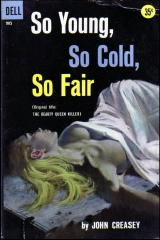
Mystery writer John Creasey fathered a small army of detectives, all of whom had “smarts” and physical prowess, though none were especially colorful. Understandably, but perhaps unfairly, Creasey’s name has often made mystery readers smile. The most prolific mystery writer, he started by writing some dreadful books in his early days.
Nor were all of them mysteries, since he wrote in all genres. (One of his early “Tex Reilly” westerns is reputed to contain the deathless line about coyotes flying in the sky.)
Creasey was best known for his Commander George Gideon books, written under the J.J. Marric pseudonym, but G.G.’s roots were clearly in his older literary brother, Inspector Roger “Handsome” West, who appeared in forty-three novels and at least one short story.
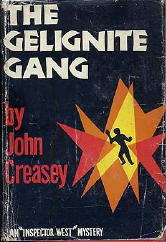
West started off rather inconspicuously in 1942, depending on a socialite friend for much of his detection and legwork. However, as the series progressed, Creasey’s writing and West, as a hero, improved.
Happily, Harper’s Perennial Library has recently reprinted eight of the Roger West series, and their selection is excellent, as witnessed by the following examples.
Serial killers are everywhere today. (I’m sure I pass them on the streets as I walk from the train to work.) The Beauty Queen Killer (1954) is a good early example, with some exciting scenes, marred only by difficult to accept motivation.
The Gelignite Gang (1955) dates from the same year as the first Marric novel, and it also gives a good picture of London from a policeman’s viewpoint.
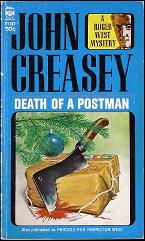
Here, the police are faced with a series of jewelry robberies, with the titular form of dynamite the common factor. When murder occurs during robbery in the city’s largest department store, West is called in to solve a mystery that has more surprises than most.
In Death of a Postman (1956) Creasey accomplishes what relatively few mystery writers do: he makes us care about the victim. A postal worker, who leaves behind a wife and five children, has been murdered during the Christmas rush. As we rapidly turn the pages of one of Creasey’s best narratives, we become involved and want West to track down a particularly heinous killer.
– From The MYSTERY FANcier, Vol. 10, No. 3, Summer 1988 (slightly revised).
Bibliographic details:
The Beauty Queen Killer. Harper & Brothers, US, hardcover, 1956. First published in the UK as A Beauty for Inspector West, Hodder & Stoughton, hc, 1954. US paperback editions include: Dell 985, 1957, as So Young, So Cold, So Fair. Berkley F1095, 1965; Lancer 74757, 1971; and Perennial, 1987.
The Gelignite Gang. Harper & Brothers, US, hardcover, 1956. First published in the UK as Inspector West Makes Haste, Hodder & Stoughton, 1955. US paperback editions include: Bantam 1884, 1959; Berkley F1176, 1966, as Night of the Watchman; Lancer, 1971, as Murder Makes Haste; and Perennial, 1987.
Death of a Postman. Harper & Brothers, US, hardcover, 1957. First published in the UK as Parcels for Inspector West, Hodder & Stoughton, 1956. US paperback editions include: Bantam 1883, 1956; Berkley F1167, 1965; and Perennial, 1987.
Wed 16 Jul 2008
ELIZABETH DALY – Night Walk.
Dell, paperback reprint; Murder Ink series #55; 1st printing, December 1982. Hardcover first edition: Rinehart & Co., 1947. Hardcover reprint: Detective Book Club, 3-in-1 edition, February 1948. Other paperback edition: Berkley F811, 1963.
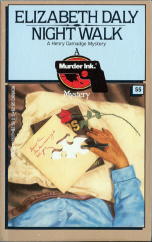
A scarce book, relatively speaking. On ABE at the moment there are only 24 copies of all of the various editions combined. The “Murder Ink” series is a nice set to own, by the way. Wouldst that a mass-market publisher would consider doing today a long series of classic detective novels like this one, with a parallel and equally long one presented under the auspices of the “Scene of the Crime” bookshop on the West Coast.
Authors like Sheila Radley, V. C. Clinton-Baddeley, W. J. Burley, Douglas Clark, Colin Watson, and Patricia Moyes (Murder Ink); and Gladys Mitchell, Anthony Berkeley, Alan Hunter, and Gwendoline Butler (Scene of the Crime). Hardly any of them even in print today.
I’ll forgo my usual bibliographic discussion of the author, Elizabeth Daly. You can read the preceding review for that. Even though I read The Book of Lion over four years ago, the same kinds of feelings were evoked this afternoon and evening in finishing up Night Walk. A strong sense of nostalgia for the past, quite definitely, but there’s also (as I suspect in all of Daly’s fiction) an unmistakable love of things literary, bookish, and yes, libraries, where a portion of the current book takes place.
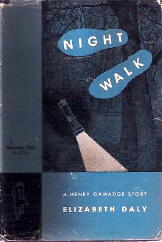
The scene is a small, isolated town in Westchester County, New York, which even though perhaps less than 50 miles from Manhattan, lives (or did in 1947) almost as though in a different, earlier era, and obviously in a far different place. A place where, if a murder occurs, it can be blamed on a tramp. A homicidal maniac, more likely.
The first four chapters, in fact, do nothing more than to follow the trail of the killer, first to a small scale rest and rehab facility for the rich and well-to-do, then the aforementioned lilbrary, then the local inn, and then and only then, to the home of the Carringtons’, where the senior member, an invalid, is later found dead in his bed.
Henry Gamadge is called in on the behest of a friend who finds himself caught up by accident by the police, a stranger to the area, but with an ulterior motive he’d rather not make public.
Gamadge, having an in with the police, a friend on the force in the city having put in a good word for him, does his usual low key type of investigation. In fact, the first 100 pages he’s on the job seem to be nothing more than retracing the steps of the killer on the path connecting his (or her) various stops along his way. Nothing seems to escape Gamadge’s attention, however.
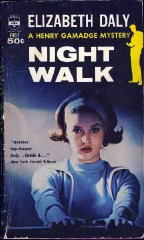
To the reader, though, the lack of a “Watson” is a bit of a frustration, as we see what Gamadge sees, but we do not have access to his thought processes. On the other hand, however, there are none of those “You know my methods,” tossed off to his subordinates as if only to tease us.
It’s a trade-off, of course, and if I were to read more of Elizabeth Daly, I think I might eventually catch on to the way she includes her clues — all very fair and above board, I might very well make sure you understand.
What it also means is that it takes the last 18 pages or so for Gamadge to explain all, and ’tis nice, the explanation is, indeed. One wishes perhaps only more stage presence from Clara, otherwise known as Mrs. Gamadge. She comes to Frazer’s Mills only at the end of the book, appearing on only one or maybe two of the pages in the last 18.
Plotwise, I might mention a small couple of glitches in the summing up or the previous telling of the tale, but they’re so minor, for what good reason, I ask myself now, should I bring them up now? So I won’t, no more than I already have.
Mon 24 Dec 2007
Posted by Steve under
CoversNo Comments
For some reason that I’ve never been able to explain — not that I’ve ever tried — there has been a long-standing connection between Christmas and the crime story, and not just in the short story format. Back when Mystery*File was still an in-print journal, I published a checklist of all of the crime, mystery and detective novels that took place on or around Christmas. It was long in its initial form, and it kept getting longer and longer as additional suggestions continued to pour in. Figuratively speaking, of course.
I’ll be taking the day off from blogging tomorrow. I sincerely hope that you will have family and friends nearby, or at least within a phone call away. In the spirit of the season, with a dose of Alfred Hitchcockian humor thrown in — well, more than a dose, I’m afraid, but the cover is nicely done — I offer you the following. Mark Hess is the artist.
MYSTERIOUS PRESS. Paperback reprint, December 1992. Hardcover edition, 1991.
Stories, all apparently first appearances:
Charlotte MacLeod — Counterfeit Christmas [Peter Shandy]
Reginald Hill — The Running of the Deer [Joe Sixsmith]
Elizabeth Peters — Liz Peters, PI [Liz Peters]
Medora Sale — Angels [Inspector John Sanders]
John Malcolm — The Only True Unraveller
Dorothy Cannell — The January Sale Stowaway
Bill Crider — The Santa Claus Caper [Carl Burns & Pecan City police chief “Boss” Napier]
Patricia Moyes — Family Christmas
Evelyn E. Smith — Miss Melville Rejoices [Susan Melville]
Eric Wright — Two in the Bush
Mickey Friedman — The Fabulous Nick
Robert Barnard — A Political Necessity
Margaret Maron — Fruitcake, Mercy, and Black-Eyed Peas [Deborah Knott]
Wed 23 Dec 2009
This list of Christmas mysteries, compiled by Caryn Wesner-Early, first appeared in Mystery*File 40, December 2003, and being all of six years old, is surely long out of date by now. Don’t that dissuade you from finding one or more of these to read over the next twelve days or so!
Adamson, Lydia. A Cat in the Manger
Adamson, Lydia. A Cat in the Wings
Adamson, Lydia. Cat on Jingle Bell Rock
Adamson, Lydia. A Cat Under the Mistletoe
Adrian, Jack. Crime at Christmas: A Seasonal Box of Murderous Delights
Alexander, David. Shoot a Sitting Duck
Allen, Garrison et al. Murder Most Merry
Allen, Michael. Spence and the Holiday Murders
Atherton, Nancy. Aunt Dimity’s Christmas
Babson, Marion. The Twelve Deaths of Christmas
Baker, Nikki. Long Goodbye
Barron, Stephanie. Jane and the Wandering Eye
Beaton, M.C. A Highland Christmas
Bernhardt, William. The Midnight Before Christmas
Black, Gavin. A Dragon for Christmas
Blades, Joe and Jeffrey Marks, eds. A Canine Christmas
Blake, Nicholas. The Corpse in the Snowman
Borthwick, J.S. Dude on Arrival
Boylan, Eleanor. Pushing Murder
Braun, Lillian Jackson. The Cat Who Turned On and Off
Braun, Lillian Jackson. The Cat Who Went Into the Closet
Brett, Simon. Christmas Crimes at Puzzle Manor
Cameron, Eleanor. The Mysterious Christmas Shell (children’s)
Cavanna. Betty. The Ghost of Ballyhooly (children’s)
Christian, Mary Blount. Sebastian (Super Sleuth) and the Santa Claus Caper (children’s)
Christie, Agatha. Hercule Poirot’s Christmas (Murder for Christmas, A Holiday for Murder)
Churchill, Jill. A Farewell to Yarns
Churchill, Jill. The Merchant of Menace
Clark, Carol Higgins. Iced
Clark, Mary Higgins. All Through the Night
Clark, Mary Higgins. Silent Night
Clark, Mary and Carol Higgins. Deck the Halls
Constantine, K.C. Upon Some Midnight Clear
Corcoran, Barbara. Mystery on Ice
Cornwell, Patricia. From Potter’s Field
Cornwell, Patricia. Scarpetta’s Winter Table
Cramer, Kathryn and David G. Hartwell (eds.) Christmas Ghosts
Crowleigh, Ann et al. Murder Under the Tree (anthology)
Daheim, Mary. The Alpine Christmas
Daheim, Mary. Nutty As a Fruitcake
Dalby, Richard, ed. Crime for Christmas (anthology)
Dalby, Richard, ed. Mystery for Christmas (anthology)
D’Amato, Barbara. Hard Christmas
Davidson, Diane. Tough Cookie
Daws, Jeanne M. The Body in the Transept
Dawson, Janet. Nobody’s Child
Delaney, Joseph. The Christmas Tree Murders
Dobson, Joanne. Quieter Than Sleep
Douglas, Carole Nelson. Cat in a Golden Garland
Drummond, John Keith. ‘Tis the Season to Be Dying
Duffy, James. The Christmas Gang
Eberhart, Mignon G. Postmark Murder
Egan, Lesley. Crime for Christmas
Elkins, Aaron. A Deceptive Clarity
Emerson, Kathy Lynn. Face Down Upon an Herbal
Erskine, Margaret. House of the Enchantress
Faglia, Leonard and David Richards. 1 Ragged Ridge Road
Fairstein, Linda. The Deadhouse
Farrell, Kathleen. Mistletoe Malice
Ferrars, E.X. Smoke Without Fire
Ferris, Monica. A Stitch In Time
Fletcher, Jessica and Bain, Donald. A Little Yuletide Murder
Fletcher, Jessica and Bain, Donald. Murder She Wrote: Manhattans and Murder
Flynn, Brian. The Murders Near Mapleton
Foley, Rae. Where is Mary Bostwick?
Frazier, Margaret. The Servant’s Tale
Gano, John. Inspector Proby’s Christmas
Godfrey, Thomas, ed. Murder for Christmas (2 vols. – anthology)
Goodman, Jonathan, ed. The Christmas Murders (anthology)
Grafton, Sue. E Is for Evidence
Granger, Anne. A Season for Murder
Greeley, Andrew M. The Bishop and the Three Kings
Greenberg, Martin H., ed. Holmes for the Holidays
Greenberg, Martin H., ed. More Holmes for the Holidays
Greenberg, Martin H. and Carol-Lynn Rossel Waugh, eds. Santa Clues (anthology)
Grimes, Martha. The Man With a Load of Mischief
Gunn, Victor. Death on Shivering Sand
Haddam, Jane. Festival of Deaths (Hanukkah)
Haddam, Jane. Not a Creature Was Stirring
Haddam, Jane. A Stillness in Bethlehem
Hager, Jean. The Last Noel
Hall, Robert Lee. Benjamin Franklin and a Case of Christmas Murder
Hardwick, Richard. The Season to Be Deadly
Hare, Cecil. An English Murder
Harris, Charlaine. Shakespeare’s Christmas
Harris, Lee. The Christmas Night Murder
Hart, Carolyn. Sugarplum Dead
Hart, Ellen. Murder in the Air
Hay, M. Doriel. The Santa Klaus Murder
Heald, Tim, ed. A Classic Christmas Crime (anthology)
Healy, Jeremiah. Right to Die
Hemlin, Tim. A Catered Christmas
Hemlin, Tim. If Wishes Were Horses…
Hess, Joan. A Holly, Jolly Murder
Hess, Joan. O Little Town of Maggody
Heyer, Georgette. Envious Casca
Hirsh, M.E. Dreaming Back
Holland, Isabelle. A Fatal Advent
Holmes for the Holidays (anthology)
Hunter, Fred. Ransome for a Holiday
Hunter, Fred. ‘Tis the Season for Murder: Christmas Crimes
Iams, Jack. Do Not Murder Before Christmas
Innes, Michael. Christmas at Candleshoes
Jaffe, Jody. Chestnut Mare, Beware
Jahn, Michael. Murder on Fifth Avenue
Jordan, Cathleen. A Carol in the Dark
Jordan, Jennifer. Murder Under the Mistletoe
Kane, Henry. A Corpse for Christmas (Homicide at Yuletide)
Keene, Carolyn. A Crime for Christmas (children’s)
Kelner, Toni L.P. Mad As the Dickens
Kelly, Mary C. The Christmas Egg
Kitchin, C.H.B. Crime at Christmas
Koch, Edward I. and Wendy Corsi Staub. Murder on 34th Street
Langton, Jane. The Shortest Day
Lake, M.D. Grave Choices
Lambert, Elisabeth. The Sleeping House Party
Lewin, Michael Z. Family Planning
Lewis, Gogo and Seon Manley, eds. Christmas Ghosts (anthology)
Livingston, Nancy. Quiet Murder
McBain, Ed. And All Through the House
McBain, Ed. Downtown
McBain, Ed. Sadie When She Died
McClure, James. The Gooseberry Fool
McGown, Jill. Murder at the Old Vicarage
McKevett, G.A. Cooked Goose
MacLeod, Charlotte, ed. Christmas Stalkings (anthology)
MacLeod, Charlotte. Convivial Codfish
MacLeod, Charlotte, ed. Mistletoe Mysteries (anthology)
MacLeod, Charlotte. Rest You Merry
Mallowan, Agatha Christie. A Star Over Bethlehem and Other Stories
Manson, Cynthia, ed. Christmas Crimes (anthology)
Manson, Cynthia, ed. Murder Under the Mistletoe (anthology)
Manson, Cynthia, ed. Mystery for Christmas and Other Stories (anthology)
Markham, Marion M. The Christmas Present Mystery (children’s)
Maron, Margaret. Corpus Christmas
Marsh, Carole. Christmas Tree Mystery
Marsh, Ngaio. Tied Up in Tinsel
Meier, Leslie. Christmas Cookie Murder
Meier, Leslie. Mail Order Murder
Meier, Leslie. Mistletoe Murder
Meredith, D.R. Death By Sacrilege
Meredith, David William. The Christmas Card Murders
Meyers, Annette. These Bones Were Made for Dancin’
Miers, Earl. The Christmas Card Murders
Mortimer, John Clifford, ed. Murder at Christmas (anthology)
Moyes, Patricia. Who Killed Father Christmas? and Other Unseasonable Demises
Muller, Marcia. Both Ends of the Night
Muller, Marcia. There’s Nothing to Be Afraid Of
Murder Most Merry (anthology)
Murder Under the Tree (anthology)
Murray, Donna Huston. The Main Line is Murder
Nordan, Robert. Death Beneath the Christmas Tree
O’Marie, Sister Carol Anne. Advent of Dying
O’Marie, Sister Carol Anne. Murder in Ordinary Time
Page, Katherine Hall. Body in the Bouillon
Peters, Ellis. Monk’s Hood
Pulver, Mary Monica. Original Sin
Queen, Ellery. The Finishing Stroke
Raphael, Lev. Burning Down the House
Ray, Robert J. Merry Christmas Murdock
Resnick, Mike and Martin H. Greenberg, eds. Christmas Ghosts (anthology)
Robb, J.D. Holiday in Death
Roberts, Gillain. The Mummers’ Curse
Robinson, Peter. Past Reason Hated
Ruell, Patrick. Red Christmas
Sawyer, Corrine Holt. Ho-Ho Homicide
Serafin, David. Christmas Rising
Shannon, Dell. No Holiday for Murder
Sibley, Celestine. Spider in the Sink
Smith, Barbara Burnett. Mistletoe from Purple Sage
Smith, Barbara Burnett et al. ‘Tis the Season for Murder
Smith, Frank. Fatal Flaw
St. John, Wylly Folk. The Christmas Tree Mystery (children’s)
Trochek, Kathy Hogan. Midnight Clear
Waugh, Carol-Lynn Rossel, ed. The Twelve Crimes of Christmas (anthology)
Weir, Charlene. A Cold Christmas
Welk, Mary V. A Deadly Little Christmas
Williams, David. Murder in Advent
Windsor, Patricia. Christmas Killer
Windsor, Patricia. A Very Weird and Moogly Christmas
Wingfield, R.D. Frost at Christmas
Witting, Clifford. Catt Out of the Bag
Wolzien, Valerie. Deck the Halls with Murder
Wolzien, Valerie. ‘Tis the Season to Be Murdered
Wolzien, Valerie. We Wish You a Merry Murder
Woolley, Catherine. Libby’s Uninvited Guest
… And Checking It Twice:
In the letter column for Mystery*File 43, Jeff Meyerson added the following:
Agatha Christie, “The Adventure of the Christmas Pudding” (title novella in ss collection)
Agatha Christie, “Christmas Adventure” in While the Light Lasts (apparently the original, shorter version of the above).
Georges Simenon, “Maigret’s Christmas” (title story in ss collection)
Bill Crider, Terence Faherty, Wendi Lee, Aileen Schumacher, Murder, Mayhem and Mistletoe (paperback original; four Christmas-related stories)
[ Jeff goes on to say: ]
Caryn should also be aware of a very entertaining pamphlet published in 1982 by Albert Memendez called Mistletoe Malice: The Life and Times of the Christmas Murder Mystery (Silver Spring, MD, Holly Tree Press). The 35 pages goes through various Christmas mysteries and includes a checklist of 89 books, of which about 60 (at fast glance) are not on Caryn’s list. I think the majority of her list is post-1982 titles.
[ Later. ] These are the ones not listed on Caryn Wesner-Early’s list in M*F 40. Obviously, most of these are older books, while much of the list in M*F consists of books published since Mistletoe Malice was published in 1982.
Anthony Abbot, About the Murder of a Startled Lady
” ” About the Murder of Geraldine Foster
North Baker, Dead to the World
W. A. Ballinger, A Corpse For Christmas
Charity Blackstock, The Foggy, Foggy Dew
Nicholas Blake, Thou Shell of Death
” ” The Smiler With the Knife
Carter Brown, A Corpse for Christmas
Leo Bruce, Such is Death (Crack of Doom)
W. J. Burley, Death in Willow Pattern
Thomas Chastain, 911
Noel Clad, The Savage
Constance Cornish, Dead of Winter
Alisa Craig (Charlotte MacLeod), Murder Goes Mumming
Joel Dane, The Christmas Tree Murders
Frederick C. Davis, Drag the Dark
Mildred Davis, Tell Them What’s Her Name Called
” ” Three Minutes to Midnight
Spencer Dean, Credit for a Murder
Carter Dickson (John Dickson Carr), The White Priory Murders
“Diplomat”, The Corpse on the White House Lawn
Todd Downing, The Last Trumpet
Francis Duncan, Murder for Christmas
Mary Durham, Keeps Death His Court
Jefferson Farjeon, Mystery in White
Elizabeth X. Ferrars, The Small World of Murder
Ian Fleming, On Her Majesty’s Secret Service
Rae Foley, The Hundredth Door
Leslie Ford, The Simple Way of Poison
Roger Gouze, A Quiet Game of Bambu
Dulcie Gray, Dead Giveaway
Dashiell Hammett, The Thin Man
Lee Hays, Black Christmas
Edith Howie, Murder for Christmas
John Howlett, The Christmas Spy
Cledwyn Hughes, The Inn Closes For Christmas (He Dared Not Look Behind)
Fergus Hume, The Coin of Edward VII
Alan Hunter, Landed Gently
Michael Innes, A Comedy of Terrors (There Came Both Mist and Snow)
Glenn Kezer, The Queen is Dead
Kathleen Moore Knight, They’re Going to Kill Me
Alfred Lawrence, Columbo: A Christmas Killing
Ted Lewis, Jack Carter’s Law
Richard Lockridge, Dead Run
Miriam Lynch, Crime for Christmas
Ed McBain, The Pusher
” ” Ghosts
Helen McCloy, Two-Thirds of a Ghost
” ” Mr. Splitfoot
” ” Burn This
Anne Nash, Said With Flowers
Stuart Palmer, Omit Flowers
Jack Pearl, Victims
Ellery Queen, The Egyptian Cross Mystery
Patrick Quentin, The Follower
M. P. Rea, Death of an Angel
Jonathan Stagge, The Yellow Taxi
Elizabeth Atwood Taylor, The Cable Car Murder
Laurence Treat, Q as in Quicksand
Charles Marquis Warren, Deadhead
If your favorite seasonal mystery (or mysteries) is (are) not here, that’s what the comments box is for!


